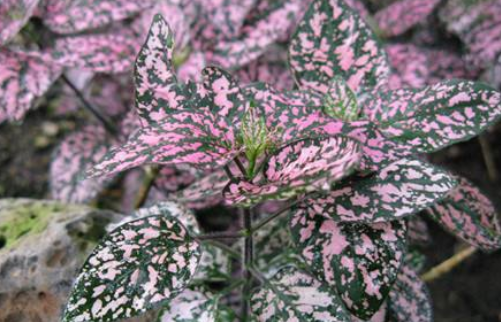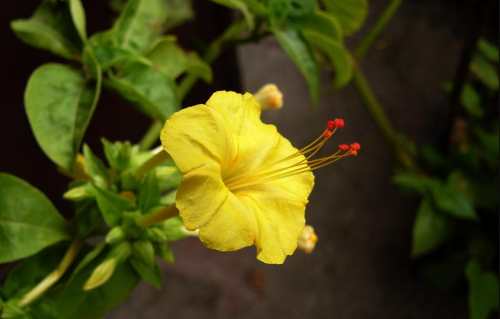How to raise red spot grass?
Soil
Red spot grass still has a high demand for soil. It likes soil that is loose and breathable, well drained, deep and fertile, rich in humus and slightly acidic. We can find raw materials for this kind of soil. We can also go to the florist to buy special soil for red spot grass.

Temperature
Red spot grass likes to grow in a warm environment, and its most suitable growth temperature is 15-18 ℃. The winter temperature is too low, and the cold tolerance of the plant is very poor, so we should pay attention to keep the plant warm and keep the temperature around the plant more than 12 ℃. Otherwise, the plant may frostbite the leaves or roots. Summer temperature is too high, we should pay attention to cooling the plant, you can give it some sunshade, and put it in a well-ventilated place.
Moisture content
Red spot grass likes the moist growth environment, so during its growth period, we should pay attention to maintain the wettability of the basin soil and often water the plants. Summer temperature is too high, to increase the number of watering, at the same time to spray water to the leaves to enhance the humidity of the air.
Light
Red spot grass likes the warm and humid semi-shady environment, likes the light, but requires partial shade or partial light, the appropriate increase of direct light can make the leaves more shiny.
The above is the introduction of how to raise red spot grass. Next, let's take a look at what else we should pay attention to in raising red spot grass.
Matters needing attention of red spot grass replacement of potted soil
When transplanting red spot grass, the soil in the new flowerpot should be added to the soil in the original flowerpot, with half of the old soil and half of the new soil in the pot. it is best to prevent the plant from dying because it does not adapt to the new environment.
After reading this article, I found that red spot grass is not difficult to raise! As long as you take care of it carefully, it can grow very exuberantly!
The growth habits and propagation methods of red spot grass
Red spot grass, also known as purples, is the green leaves covered with red dots, used to see green leaves, such a style of leaves are still very characteristic. So, do you want to know what are the planting techniques for red spot grass? Do you want to raise red spot grass? Today, the editor, next we will come to know the red spot grass this plant.
Another name for red spot grass
Purples, rhododendron tears grass, pink grass, red vines, red spot grass, red spot crucian carp gall, small raindrops.
Morphological characteristics of Red spot Grass
Red spot grass is a perennial evergreen herb, native to Madagascar. Plant height is about 70cm, potted seedling height 20~30cm, leaves opposite, entire, leaf surface olive green, covered with pink or white spots.
Red spot grass has many varieties, such as "pink cream", "red frost", "rose red frost" and "white frost" and so on. Can bloom in spring, the flower is small, inconspicuous, for lavender small spike flower.
Growth habits of Red spot Grass
Red spot grass like warm, humid and semi-shaded environment, like light, partial shade or partial light, appropriate increase of direct light can also increase the color of leaves.
Not cold-resistant, suitable temperature 15-18 ℃, overwintering temperature more than 12 ℃. It is suitable for loose, slightly acidic, deep and fertile soil, permeable and rich in humus.
The Propagation method of Red spot Grass
The suitable sowing time is in spring and autumn, the optimum temperature for germination is about 20 ℃, and the suitable temperature for growth is about 15-25 ℃.
The survival rate of cuttings is high, cutting the terminal buds or branches, cutting 2-3 nodes in each section, cutting them in the soil to maintain moisture. During the cutting period, the cutting speed is mostly diluted by 1000 times and sprayed every ten days to promote rooting, which can be rooting after about 3-4 weeks. Indoor display should be in a place with sufficient daylight, and the overwintering temperature should be above 12 ℃.
This is what I know about herbaceous plants today. I hope it will be helpful for you to read this article. If you want to know more about herbaceous flowers, please continue to pay attention to our succulent flower beds. We will provide you with more relevant content as soon as possible!
- Prev

Cultivation techniques of Artemisia mandshurica
Cultivation techniques of Artemisia mandshurica
- Next

How to raise purple jasmine
Purple jasmine likes sunlight very much, so it is necessary to give the plant enough light to maintain its normal growth during the growing period, but in summer, the hot weather and violent sunlight make it impossible for the plant to be placed in the light, otherwise the leaves of the plant may be burned, so we have to give the plant shade.
Related
- Fuxing push coffee new agricultural production and marketing class: lack of small-scale processing plants
- Jujube rice field leisure farm deep ploughing Yilan for five years to create a space for organic food and play
- Nongyu Farm-A trial of organic papaya for brave women with advanced technology
- Four points for attention in the prevention and control of diseases and insect pests of edible fungi
- How to add nutrient solution to Edible Fungi
- Is there any good way to control edible fungus mites?
- Open Inoculation Technology of Edible Fungi
- Is there any clever way to use fertilizer for edible fungus in winter?
- What agents are used to kill the pathogens of edible fungi in the mushroom shed?
- Rapid drying of Edible Fungi

